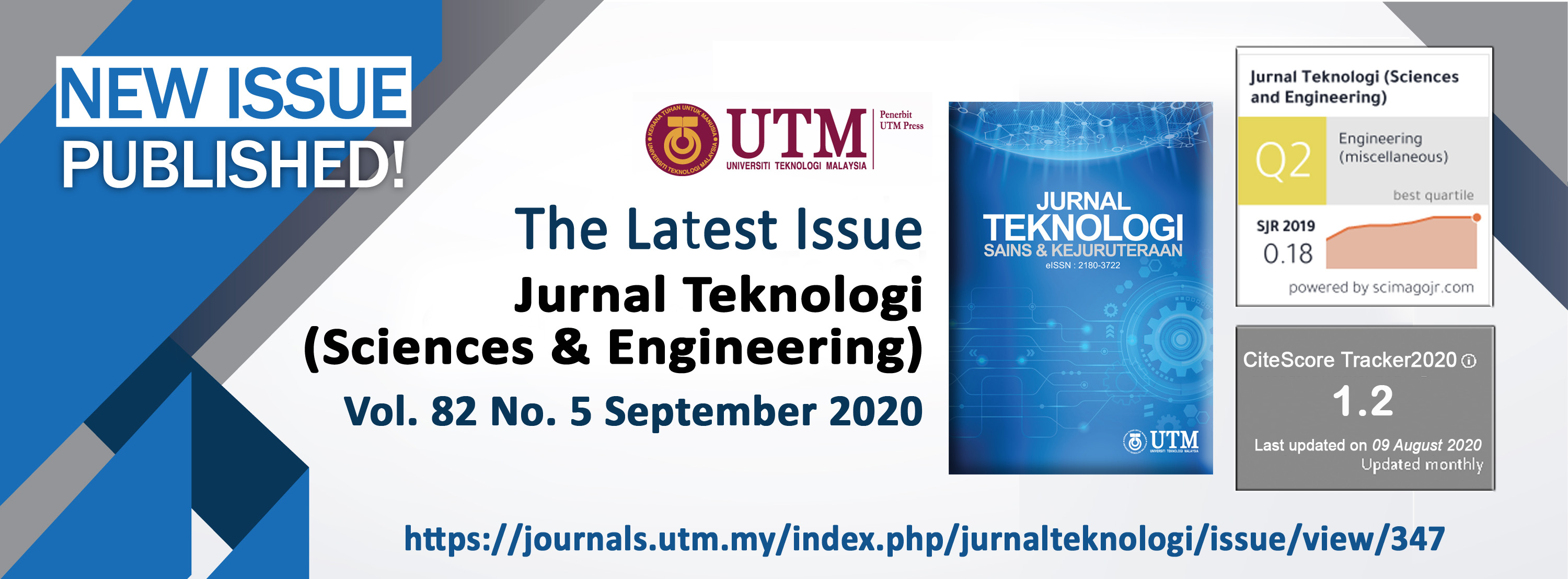ASSOCIATED EFFECT OF PERFORATION POSITION AND DIAMETER ON THERMAL PERFORMANCE OF PLANE FIN UNDER NATURAL CONVECTION ENVIRONMENT
DOI:
https://doi.org/10.11113/jt.v82.14157Keywords:
Perforation positions, perforated plain fins, perforation diameter, Nusselt number, fin temperature distributionAbstract
The fin perforation represents an efficient way to reduce fins weight and enhance its thermal performance. In this study, rectangular plane fins were designed and fabricated aiming to experimentally investigate the effect of the perforation, perforations position and diameter on the solid fins thermal performance under natural convection heat transfer conditions. The experiments were conducted at a wide range of the supplied heat fluxes, and also covered three perforations positions (bottom, middle, top) and perforations diameters (3, 5, 7) mm. At all the used diameters, results showed that the middle position for perforations performed the best in terms of the Nusselt number and mean surface temperature. The maximum Nusselt number and mean surface temperature were 662.08 and 71.95 oC respectively when the heat flux was 4181.82 W/m2, and the perforation diameter was 3.0 mm. The thermal performance of the top-perforated fins was slightly smaller than that of the middle-perforated fins. Besides, the bottom perforated fins demonstrated the worst thermal performance in terms of Nusselt number and the mean surface temperature. Regarding the effect of the perforation diameter, the 3.0 mm showed superior thermal performance compared with 5.0 mm, and 7.0 mm regardless of the perforation’s positions.
References
Huang, C.-H., Liu, Y.-C., and Ay, H. 2015. The Design of Optimum Perforation Diameters for Pin Fin Array for Heat Transfer Enhancement. International Journal of Heat and Mass Transfer. 84752-765.
Jafari, D., and Wits, W. W. 2018. The Utilization of Selective Laser Melting Technology on Heat Transfer Devices for Thermal Energy Conversion Applications: A Review. Renewable and Sustainable Energy Reviews. 91420-442.
Shaeri, M. R., and Yaghoubi, M. 2009. Numerical Analysis of Turbulent Convection Heat Transfer from an Array of Perforated Fins. International Journal of Heat and Fluid Flow. 302: 218-228.
Shaeri, M. R., and Bonner, R. W. 2019. Analytical Heat Transfer Model for Laterally Perforated-finned Heat Sinks. International Journal of Heat and Mass Transfer. 1311164-1173.
Ahmed, H. E., Salman, B. H., Kherbeet, A. S., and Ahmed, M. I. 2018. Optimization of Thermal Design of Heat Sinks: A Review. International Journal of Heat and Mass Transfer. 118129-153.
Kumar, S., Kumar, A., Darshan Kothiyal, A., and Singh Bisht, M. 2018. A Review of Flow and Heat Transfer Behaviour of Nanofluids in Micro Channel Heat Sinks. Thermal Science and Engineering Progress. 8477-493.
Shaeri, M. R., Yaghoubi, M., and Jafarpur, K. 2009. Heat Transfer Analysis of Lateral Perforated Fin Heat Sinks. Applied Energy. 8610: 2019-2029.
Calautit, J. K., Hughes, B. R., Chaudhry, H. N., and Ghani, S. A. 2013. CFD Analysis of a Heat Transfer Device Integrated Wind Tower System for Hot and Dry Climate. Applied Energy. 112576-591.
Elshafei, E. A. M. 2010. Natural Convection Heat Transfer from a Heat Sink with Hollow/Perforated Circular Pin Fins. 2010 3rd International Conference on Thermal Issues in Emerging Technologies Theory and Applications. 185-193.
Ibrahim, T. K. et al. 2018. Experimental Study on the Effect of Perforations Shapes on Vertical Heated Fins Performance Under Forced Convection Heat Transfer. International Journal of Heat and Mass Transfer. 118832-846.
Huang, C.-H., and Chen, M.-H. 2019. An Estimation of the Optimum Shape and Perforation Diameters for Pin Fin Arrays. International Journal of Heat and Mass Transfer. 13172-84.
Al-Damook, A., Kapur, N., Summers, J. L., and Thompson, H. M. 2015. An Experimental and Computational Investigation of Thermal Air Flows through Perforated Pin Heat Sinks. Applied Thermal Engineering. 89365-376.
Awasarmol, U. V., and Pise, A. T. 2015. An Experimental Investigation of Natural Convection Heat Transfer Enhancement from Perforated Rectangular Fins Array at Different Inclinations. Experimental Thermal and Fluid Science. 68145-154.
Al-Doori, W. 2011. Enhancement of Natural Convection Heat Transfer from the Rectangular Fins by Circular Perforations.
Cengel, Y. A. 2002. Heat Transfer. Second Edition Ed.
Xu, H. J., Xing, Z. B., Wang, F. Q., and Cheng, Z. M. 2019. Review on Heat Conduction, Heat Convection, Thermal Radiation and Phase Change Heat Transfer of Nanofluids in Porous Media: Fundamentals and Applications. Chemical Engineering Science. 195462-483.
Shaeri, M. R., and Jen, T.-C. 2012. The Effects of Perforation Sizes on Laminar Heat Transfer Characteristics of an Array of Perforated Fins. Energy Conversion and Management. 64328-334.
Bernardes, M. A. D. S. 2011. Developments in Heat Transfer. Croatia: InTech.
Mert Cuce, P., and Cuce, E. 2013. Optimization of Configurations to Enhance Heat Transfer from a Longitudinal Fin Exposed to Natural Convection and Radiation. International Journal of Low-Carbon Technologies. 94: 305-310.
Downloads
Published
Issue
Section
License
Copyright of articles that appear in Jurnal Teknologi belongs exclusively to Penerbit Universiti Teknologi Malaysia (Penerbit UTM Press). This copyright covers the rights to reproduce the article, including reprints, electronic reproductions, or any other reproductions of similar nature.
















